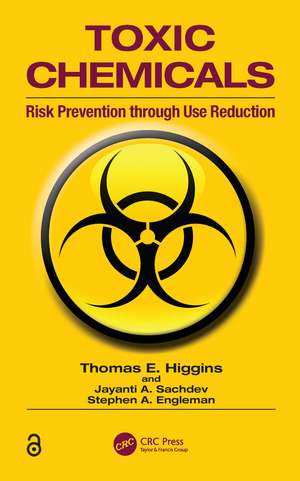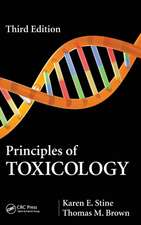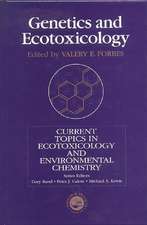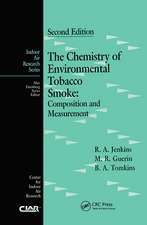Toxic Chemicals: Risk Prevention Through Use Reduction
Autor Thomas E. Higgins, Jayanti A. Sachdev, Stephen A. Englemanen Limba Engleză Paperback – 31 mai 2017
Explores all factors that contribute to toxicity
The book begins by exploring the history of toxic chemical release reporting programs, a trend growing out of the Bhopal tragedy. It surveys their impact both in the United States through the Toxics Release Inventory (TRI) program and in the 29 other countries that maintain similar programs. Then, with the goal of developing a rational method of prioritizing toxic chemicals for reduction, the authors discuss mobility, persistence, and bioconcentration adjustment factors and present a method for integrating all of these factors to estimate the relative impact of chemical release.
Compares alternate emphases in existing programs
The book describes programs that concentrate on reducing the release of chemicals with the greatest adverse toxic impact and those that require companies to prepare pollution prevention plans and set goals for reducing use or release. It also examines technical assistance programs that help companies search for alternative chemicals to use or process changes that eliminate the use of toxic chemicals. In addition, it explores alternative market-based approaches for achieving environmental protection.
Presents a workable plan for the future
In the final chapters, the authors lay out their proposed program for reducing the use of toxic chemicals. This plan builds on the existing TRI program and uses lessons learned from this and other programs. The combined research assembled by the authors and their multifaceted approach to the issue of chemical toxicity enables companies and policy makers to move to the next level of toxic chemical use reduction, resulting in a safer environment for future generations.
| Toate formatele și edițiile | Preț | Express |
|---|---|---|
| Paperback (1) | 585.27 lei 43-57 zile | |
| CRC Press – 31 mai 2017 | 585.27 lei 43-57 zile | |
| Hardback (1) | 1387.80 lei 43-57 zile | |
| CRC Press – 8 noi 2010 | 1387.80 lei 43-57 zile |
Preț: 585.27 lei
Preț vechi: 688.56 lei
-15% Nou
Puncte Express: 878
Preț estimativ în valută:
111.99€ • 117.22$ • 93.21£
111.99€ • 117.22$ • 93.21£
Carte tipărită la comandă
Livrare economică 31 martie-14 aprilie
Preluare comenzi: 021 569.72.76
Specificații
ISBN-13: 9781138116191
ISBN-10: 113811619X
Pagini: 352
Ilustrații: 14
Dimensiuni: 156 x 234 x 19 mm
Greutate: 0.45 kg
Ediția:1
Editura: CRC Press
Colecția CRC Press
Locul publicării:Boca Raton, United States
ISBN-10: 113811619X
Pagini: 352
Ilustrații: 14
Dimensiuni: 156 x 234 x 19 mm
Greutate: 0.45 kg
Ediția:1
Editura: CRC Press
Colecția CRC Press
Locul publicării:Boca Raton, United States
Cuprins
Introduction. Toxic Chemical Composition Reporting. Toxic Chemical Release Reporting. TRI Programs in Other Countries. TRI Program Impacts on Reducing Toxic Chemical Releases. Quantifying Toxicity. Quantifying Mobility. Quantifying Persistence. Quantifying Bioconcentration. Developing Effective Toxicity Factors. Focusing on Impact Chemicals. Use versus Release Reporting. Pollution Prevention Planning. Technical Assistance. Market-Based Approaches to Environmental Protection. A Program to Reduce Toxic Chemical Use. Costs and Benefits. Appendix A: Chemicals List with CAS Numbers. Appendix B: CAS Numbers with Chemical Names.
Notă biografică
Dr. Tom Higgins is one of the early founders and shapers of waste minimization and pollution prevention. He is a frequently invited speaker at technical conferences, company workshops, and board of directors to talk about Pollution Prevention. He has assisted companies and governmental agencies in setting up Pollution Prevention programs in the US, Germany, Great Britain, Italy, Canada, Hungary, Poland, Russia, Uzbekistan, Taiwan, Mainland China, Australia, and Brazil.
Recenzii
Higgins, Sachdev, and Engleman are environmental engineers with a career-long mission to control hazardous waste by minimizing waste releases rather than just treating wastes. The existing Toxics Release Inventory program (TRI) requires reporting release of chemicals as poundage, with no regard for risk factors. ... truly effective waste reduction programs require application of additional factors, including toxicity factors, air/water mobility factors, environmental persistence, and bioconcentration. Integration of all of these factors with the poundage released yields meaningful relative impact data or effective toxicity factors. This book provides tables of all of these data for hundreds of reportable chemicals. The authors also describe TRI programs for foreign countries, pollution prevention and waste reduction programs for eight states, and program costs. An appendix provides lists of chemicals with their CAS Registry Numbers. Valuable for safety and environmental engineers, toxicologists, ecologists, those in environmental policy positions, legislators, journalists, and the concerned public, as well as students in the relevant disciplines. Summing Up: Recommended. Upper-division undergraduates and above; general audiences.
—R.E. Buntrock, formerly University of Maine, in CHOICE, June 2011, Vol. 48, No. 10
—R.E. Buntrock, formerly University of Maine, in CHOICE, June 2011, Vol. 48, No. 10
Descriere
Catastrophic events such as the Bhopal, India tragedy and rising incidences of cancer in areas neighboring industrial facilities have heightened concern over the use of toxic chemicals in manufacturing and industry. Based on the authors' research conducted in Sao Paulo this book explores the history of toxic chemical release reporting programs.










